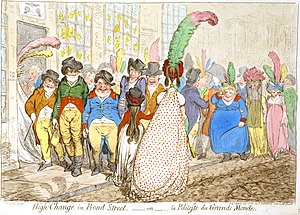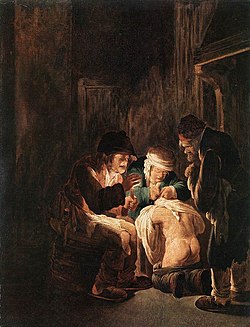Etiquette
From Wikipedia, the free encyclopedia

Etiquette, one aspect of decorum, is a code that governs the expectations of social behavior, according to the contemporary conventional norm within a society, social class, or group. Usually unwritten, it may be codified in written form. Etiquette usually reflects formulas of conduct in which society or tradition have invested. An etiquette may reflect an underlying ethical code, or it may grow more as a fashion, as in eighteenth century Britain where apparently pointless acts like the manner in which a tea cup was held became associated with the upper class. Like "culture", it is a word that has gradually grown plural, especially in a multi-ethnic society with many clashing expectations. Thus, it is now possible to refer to "an etiquette" or "a culture", realizing that these may not be universal. In Britain, though, the word etiquette has its roots in the eighteenth century, becoming a universal force in the nineteenth century to the extent that it has been described as the one word that aptly describes life during the reign of Queen Victoria [1].
Contents[hide] |
Norms and effects of etiquette
| This section may contain original research or unverified claims. Please improve the article by adding references. See the talk page for details. (September 2007) |
Etiquette codes prescribe and restrict the ways in which people interact with each other, based on respect for other people and the accepted customs of a society.
Modern etiquette codifies social interactions with others, such as:[citation needed]
- Greeting relatives, friends and acquaintances with warmth and respect
- Refraining from insults and prying curiosity
- Offering hospitality to guests
- Wearing clothing suited to the occasion
- Contributing to conversations without dominating them
- Offering assistance to those in need
- Eating neatly and quietly
- Avoiding disturbing others with unnecessary noise
- Following established rules of an organization upon becoming a member
- Arriving promptly when expected
- Comforting the bereaved
- Responding to invitations promptly
- Accepting gifts or favors with humility and to acknowledge them promptly with thanks or refusing the gift politely (e.g. a thank-you card)
In the upper strata of Roman society, etiquette would have instructed a man to: greet friends and acquaintances with decorum, according to their rank, refrain from showing emotions in public, keep his wife(s) secluded from his clients, support his family's position with public munificence, etc. Lower strata conformed to different rules.[citation needed]
Violations of etiquette, if severe, can cause public disgrace, and in private hurt individual feelings, create misunderstandings or real grief and pain, and can even escalate into murderous rage. Many family feuds have their beginnings in trivial etiquette violations that were blown out of proportion. In the ancient Hindu epic Mahabharata, the entire world-destroying conflict between the armies of two clans begins when one ruler, Duryodhana, commits a couple of minor faux pas at his cousin's castle, and is impolitely made fun of for it. one can reasonably view etiquette as the minimal politics required to avoid major conflict in polite society, and as such, an important aspect of applied ethics.
Manners
Manners involve a wide range of social interactions within cultural norms as in the "comedy of manners", or a painter's characteristic "manner". Etiquette and manners, like mythology, have buried histories especially when they seem to have little obvious purpose, and their justifications as logical ("respect shown to others" etc.) may be equally revealing to the social historian.
In the West, the notion of etiquette, being of French origin and arising from practices at the court of Louis XIV, is occasionally disparaged as old-fashioned or elite, a Likecode concerned only with "which fork to use". Some people consider etiquette to be an unnecessary restriction of freedom of personal expression; others consider such free spirits to be unmannerly and rude. For instance, wearing pajamas to a wedding in a cathedral may be an expression of the guest's freedom, but may also cause the bride and groom to suspect that the guest in pajamas is expressing amusement or disparagement towards them and their wedding. Etiquette may be enforced in pragmatic ways: "No shoes, no shirt, no service" is a notice commonly displayed outside stores and cafés in the warmer parts of North America. Others feel that a single, basic code shared by all makes life simpler and more pleasant by removing many chances for misunderstandings.
Cultural differences
Etiquette is dependent on culture; what is excellent etiquette in one society may shock another. Etiquette evolves within culture. The Dutch painter Andries Both shows that the hunt for head lice (illustration, right), which had been a civilized grooming occupation in the early Middle Ages, a bonding experience that reinforced the comparative rank of two people, one groomed, one groomer, had become a peasant occupation by 1630. The painter portrays the familiar operation matter-of-factly, without the sarcasm this subject would have received in a nineteenth-century representation.
Etiquette can vary widely between different cultures and nations. In China, a person who takes the last item of food from a common plate or bowl without first offering it to others at the table may be seen as a glutton and insulting the generosity of the host. In most European cultures a guest is expected to eat all of the food given to them, as a compliment to the quality of the cooking.
Etiquette is a topic that has occupied writers and thinkers in all sophisticated societies for millennia, beginning with a behavior code by Ptahhotep, a vizier in ancient Egypt's Old Kingdom during the reign of the Fifth Dynasty king Djedkare Isesi (ca. 2414–2375 B.C.). All known literate civilizations, including ancient Greece and Rome, developed rules for proper social conduct. Confucius included rules for eating and speaking along with his more philosophical sayings. Early modern conceptions of what behavior identifies a "gentleman" were codified in the sixteenth century, in a book by Baldassare Castiglione, Il Cortegiano ("The Courtier"); its codification of expectations at the Este court remained in force in its essentials until World War I. Louis XIV established an elaborate and rigid court ceremony, but distinguished himself from the high bourgeoisie by continuing to eat, stylishly and fastidiously, with his fingers. An important book about etiquette is Galateo, overo de' costumi by Monsignor Giovanni della Casa; in fact, in Italian, etiquette is generally called galateo (or etichetta or protocollo).
In the UK, Debrett's is considered by many to be the arbiter of etiquette; their guides to manners and form have long been the last word among polite society. Traditional publications such as Correct Form have recently been updated to reflect contemporary society, and new titles Etiquette for Girls and Manners for Men act as guides for those who want to combine a modern lifestyle with traditional values.
In the American colonies Benjamin Franklin and George Washington wrote codes of conduct for young gentlemen. The immense popularity of advice columns and books by Letitia Baldrige and Miss Manners shows the currency of this topic. Even more recently, the rise of the Internet has necessitated the adaptation of existing rules of conduct to create Netiquette, which governs the drafting of email, rules for participating in an online forum, and so on.
In Germany, there is an "unofficial" code of conduct, called the Knigge, based on a book of high rules of conduct written by Adolph Freiherr Knigge in the late 18th century entitled exactly Über den Umgang mit Menschen (On Human Relations). The code of conduct is still highly respected in Germany today and is used primarily in the higher society.
Etiquette may be wielded as a social weapon. The outward adoption of the superficial mannerisms of an in-group, in the interests of social advancement rather than a concern for others, is a form of snobbism, lacking in virtue.
Western business etiquette
The etiquette of business is the set of written and unwritten rules of conduct that make social interactions run more smoothly. Office etiquette in particular applies to coworker interaction, excluding interactions with external contacts such as customers and suppliers. Both office and business etiquette overlap considerably with basic tenets of netiquette. The conventions of office etiquette address unique, office environmental issues such as cubicle life, usage of common areas, meetings, and other forms of social interaction within the context of a work setting. The rules of office etiquette may vary by region, office size, business specialty, company policy, and, to a certain degree, various laws governing the workplace. Larger organizations tend to have stricter, expressly written rules on etiquette.[citation needed] These rules are often echoed throughout an industry or economy. For instance, 49% of employers surveyed in 2005 by the American National Association of Colleges and Employers found that non-traditional attire would be a "strong influence" on their opinion of a potential job candidate.[1]
'散策길에서 <外>' 카테고리의 다른 글
| 덧없고 부질없는 인생길 (0) | 2008.09.07 |
|---|---|
| 예절과 인사 (0) | 2008.08.22 |
| 허튼 말이나 할 때가 아니다. 오늘을 잘 살리라. (0) | 2008.08.19 |
| Bias (0) | 2008.04.29 |
| 偏見, prejudice (0) | 2008.04.29 |
